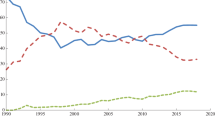Abstract
In the post-Soviet period, subsidiary household farming transformed from an “auxiliary” complementary type of activity as understood in Soviet terms into an important form of occupation and source of income for, primarily, residents of rural areas and small towns. However, the dramatic increase in the subsidiary household farms contribution to food production in the 1990s halted at the beginning of the 21st century and subsequently reversed to downturn. The absolute sizes of subsidiary household farming declined more rapidly in Non-Chernozem regions with an aged population as the large Soviet-style agricultural enterprises that fed it were liquidated. Animal husbandry production by subsidiary household farms grew increasingly concentrated in the southern regions of European Russia and Western Siberia. Based on official statistics, the article analyzes the leading factors that governed the regional peculiarities of subsidiary household farming transformation in the post-Soviet period. Its major types are identified, including involvement the dynamics of animal husbandry production, which is the most intensive part of subsidiary household farming.
Similar content being viewed by others
References
Alekseev, A.I. and Koryukhin, D.A., Inversion of rural urbanization?, Vestn. Mosk. Univ., Ser. 5: Geogr., 2017, no. 5, pp. 103–105.
Averkieva, K.V., Dan’shin, A.I., Zemlyanskii, D.Yu., and Lamanov, S.V., Strategic challenges of the development of agriculture in Russia, Reg. Res. Russ., 2017, vol. 7, no. 4, pp. 322–332.
Vinogradskii, V.G., Generational transformations of rural communities: elements, forms, and prospects, Vestn. Sarat. Gos. Sots.-Ekon. Univ., 2016, no. 1 (60), pp. 58–62.
Ioffe, G.V. and Nefedova, T.G., Center and periphery in Russian regions’ agriculture, Vopr. Progrnoz., 2001, no. 6, pp. 100–110.
Ioffe, G.V., Sel’skoe khozyaistvo Nechernozem’ya: Territorial’nye problemy (Agriculture in Non-Chernozem Zone: Territorial Problems), Moscow: Nauka, 1990.
Kalugina, Z.I. and Fadeeva, O.P., New paradigm of rural development, Mir Ross.: Sotsiol., Etnol., 2009, vol. 18, no. 2, pp. 34–49.
Kopach, K.V., Lichnoe podsobnoe khozyaistvo sel’skogo naseleniya i ego integratsiya s predpriyatiyami agropromyshlennogo kompleksa (Subsidiary Household Farming of Rural Population and Its Integration with Agricultural Complex), Moscow: Rosinformagrotekh, 2002.
Lysenko, E.G., Subsidiary household farms: present and prospective development, Ekon. S-kh. Pererab. Predpr., 2008, no. 9, pp. 1–4.
Nefedova, T.G., Regionalization in agriculture, in Regionalizatsiya v razvitii Rossii: geograficheskie protsessy i problemy (Regionalization in Development of Russia: Geographic Processes and Problems), Moscow: Inst. Geogr., Ross. Akad. Nauk, 2001.
Nefedova, T.G., Desyat’ aktual’nykh voprosov o sel’skoi Rossii: otvety geografa (Ten Topical Issues about Rural Russia: A Geographer’s Viewpoint), Moscow: Lenand, 2013.
Nefedova, T.G. and Pallot, J., Neizvestnoe sel’skoe khozyaistvo ili Zachem Nuzhna korova? (Unknown Agriculture, or Why Do We Need a Cow?), Moscow: Novoe Izdatel’stvo, 2006. In English: Pallot, J. and Nefedova, T., Russia’s Unknown Agriculture. Household Production in Post-Socialist Rural Russia, Oxford: Oxford University Press, 2007.
Maksimov, V.A., Geografiya sel’skoi mestnosti: Problemy i metody issledovaniya (Geography of Rural Area: Problems and Study Methods), Rakitnikov, A.N., Ed., Ufa: Bashkir. Gos. Univ., 1992.
Nikonov, A.A., Spiral’ mnogovekovoi dramy: Agrarnaya nauka i politika Rossii (18–20 vv.) (The Helix of the Centuries-Old Drama: Agrarian Science and Policy in Russia (18th–20 th Centuries)), Moscow: Entsiklopediya Ross. Dereven’, 1995.
Fadeeva, O.P., Sel’skie soobshchestva i khozyaistvennye ukaldy: ot vyzhivaniya k razvitiyu (Rural Communities and Economic Structures: From Survival to Development), Kalugina, Z.I., Ed., Novosibirsk: Inst. Ekon. Org. Prom. Proizvod., Sib. Otd., Ross. Akad. Nauk, 2015.
Fomina, I.V., Subsidiary household farms as an additional resource for the development of agricultural production (case study of Saratov oblast), Extended Abstract of Cand. Sci. (Econ.) Dissertation, Saratov, 2007.
Shepeleva, E.A., Development of subsidiary household farms: factors, trends, and prospects, Extended Abstract of Cand. Sci. (Econ.) Dissertation, St. Petersburg, 2004.
Bogachev, D.V., Transformation of the agriculture in Russia: Significance of present-day vertical integration, Reg. Res. Russ., 2015, vol. 5, no. 4, pp. 392–401.
Author information
Authors and Affiliations
Corresponding author
Additional information
Original Russian Text © A.I. Alekseev, S.G. Safronov, 2017, published in Regional’nye Issledovaniya, 2017, No. 4, pp. 24–35.
Rights and permissions
About this article
Cite this article
Alekseev, A.I., Safronov, S.G. Subsidiary Household Farming in Russian Regions in the Late 20th–Early 21st Centuries. Reg. Res. Russ. 8, 364–374 (2018). https://doi.org/10.1134/S2079970518040019
Received:
Published:
Issue Date:
DOI: https://doi.org/10.1134/S2079970518040019



